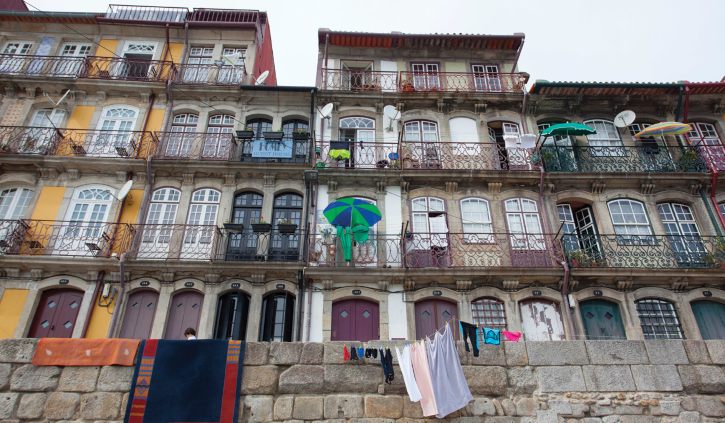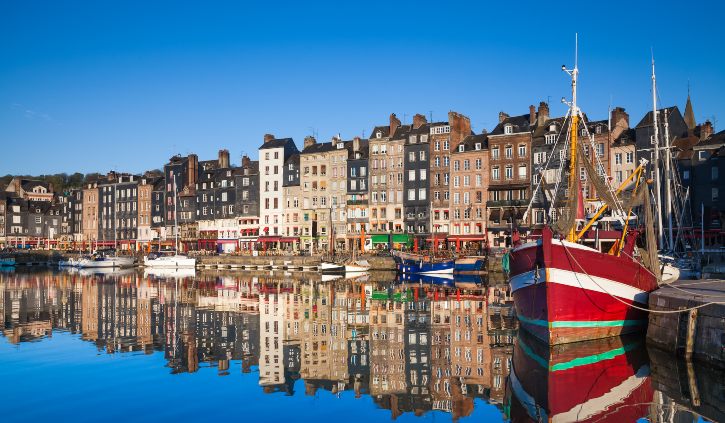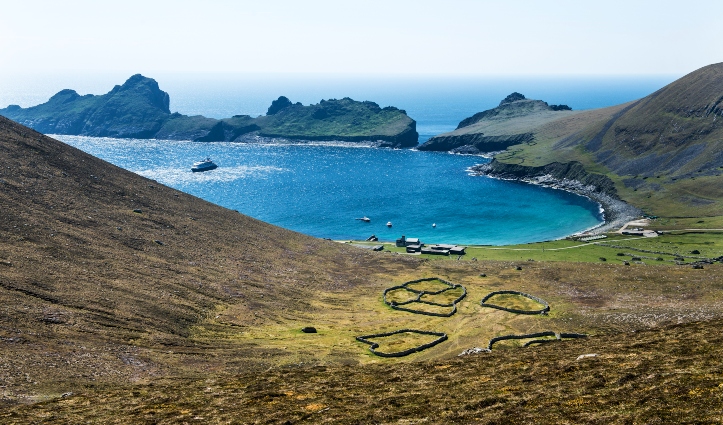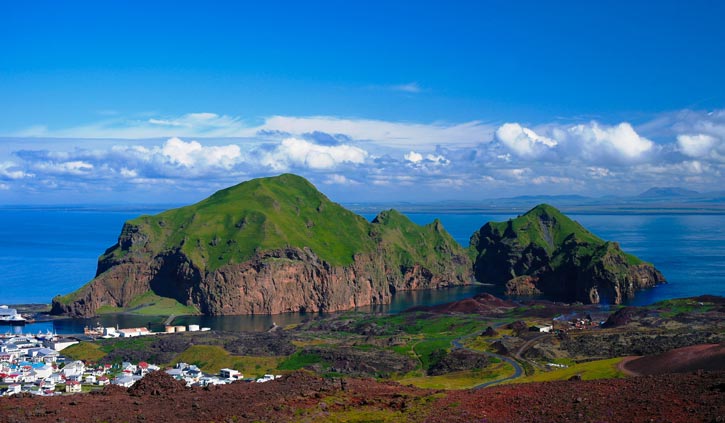
Lisbon to Reykjavik
STYLE: LUXURY
Celebrate summer’s arrival in northern Europe’s most beautiful spots. Leaving Lisbon, Portugal – and its eponymous wine – travel to Brittany and Normandy to see the famous Bayeux Tapestry, walk the D-Day beaches and why not shuck a few oysters? Two days is London offers urban respite before sailing north towards Scotland’s royal heritage and ending in Reykjavik, Iceland
ITINERARY SUMMARY

DAY 1 Lisbon, Portugal

A glorious mosaic of beauty, freedom and authenticity, Portugal’s capital is a stirring artwork of a city. Known for the seven hills it spreads across, and its stirring fado music, Lisbon is a pastel-coloured blend of houses and beautiful tile artworks – and this creative city strikes a perfect harmony between natural and man-made beauty. Stroll along Alfama’s steep, cobbled streets as you explore one of the city’s oldest neighbourhoods – where each house and door could be its own photograph. Look for the decorative tiles, with the distinctive blues and whites of Azulejo ceramics, and visit the dedicated museum to learn more. Afterwards, wind up to São Jorge Castle, where views out across Lisbon’s red rooftops unravel. Just one of many majestic viewpoints, you can also seek out Miradouro da Graça for perhaps Lisbon’s finest panorama, with the copper-coloured suspension bridge stretching over sparkling water beyond the sea of buildings.
The elegant Tower of Belém rises in the Tagus estuary and is a historic defender of these shores. The grand, carved cloisters of Jerónimos Monastery spread out close by, and there’s another UNESCO recognised location close by at Sintra, where a colourful town is set amid thick gardens and towering mountains – capped by the royal Pena Palace. Later, relax and take a quick break to drink Ginjinha, a cherry liqueur made from chocolate cups instead of coffee. Lisboetas have a sweet tooth, and the famous Pastel de Nata’s crumbling pastry and caramelised-custard topping is the essential accompaniment to any coffee stop. Embark Silver Cloud.
DAY 2 Oporto, Portugal

Steep, stacked banks of evocative buildings and cobbled streets perch scenically over the River Duoro, in this authentic, atmospheric Portuguese city. Famed for its wine and bright azulejo tiles – which turn streets into art galleries – Oporto is a charming taste of the real Portugal. Wander the uneven paths of the country’s second-largest city, which are soaked with history, tradition and eye-catching details. Start in the gorgeous, historic Ribeira neighbourhood at the River Douro, and walk up through tiny alleys and narrow streets lined with restaurants and cafes. Catch your breath with a coffee, and be sure to try the famous pastel de nata pastry as a sweet accompaniment. Enjoy views of the colourful city from the skeletal Ponte de Dom Luis I bridge. Its design might ring a bell – the structure was created by a student of Gustav Eiffel, and has a similar aesthetic to his famous tower creation. The climate nurtures the revered vineyards, which surround the city, helping to produce harvests of perfect grapes. Head out to landscapes coated in vineyards from the Douro Valley to try some of the finest local wines.
DAY 3 La Coruna, Spain

Revolving around its golden urban beaches, La Coruna is a bustling, historic city, which sits along the twisted Galician coastline. One of Spain’s most undiscovered, under-the-radar destinations, La Coruna boasts juicy seafood and unbridled relaxation beside the Mediterranean’s rustling waves, and is set amid a surprisingly lush and vibrant green landscape. A pilgrimage to Santiago de Compostella’s cultural wonders is also easily within your reach from these shores. The narrow streets of the historic centre open out to the vast Plaza de Maria Pita, which is crowned by the triple domes of the City Hall. Cafes and restaurants spill out around the square, perfect for hunkering down for coffee or a glass of refreshing white Albariño wine. Head to Calle Estrella, to taste the fruits of the Atlantic and La Coruna’s seafood – grilled octopus is a particular speciality.
If you’re in a hurry, grab some empanada pastries, filled with minced beef, or head to the City Market, which is packed with Galician flavours and intrigues. Back at the seafront, the peninsula tempts with strolls out to one of the most storied lighthouses in Spain. Still watching the waves after almost 2,000 years, the Tower of Hercules was built by the Romans in the 2nd century, and this UNESCO World Heritage Site rises 55 metres above the Atlantic – making it Spain’s second tallest. The winding Paseo Marítimo coastal path skirts beaches and the city’s endless waterfront, and is dotted with colourful artworks.
DAY 4 AT SEA

DAY 5 Saint Malo (Brittany), France

Saint-Malo is a historic and resilient walled city, which watches out over golden sands and island fortresses. Strung tenuously to the mainland, Saint Malo was the historic home of a rowdy mix of skilled sailors and new world explorers – as well as the plunderers who earned the place its ‘Pirate City’ title. Some of history’s great voyages have launched from here – including Jacques Cartier’s, which led to the settlement of New France and modern-day Quebec. Founded by a Welsh monk, who made his way here in the 6th century, Saint Malo’s castle is forged from sheer granite, and its steep defensive ramparts arise defiantly. The atmospheric walled town turns its back to the mainland and gazes out longingly into the sea. Explore streets that breathe with maritime tales and medieval charm – restored from the intense damage sustained during the Second World War. Cathédrale de St Malo rises above the tight paths, offering views of the peppered islands and fortifications. Boatloads of fresh oysters and scallops are heaved ashore – savour them or grab savoury crepes galettes, stuffed with cheese and ham. Wash Saint Malo’s foods down with a Brittany cider, which challenges wine as the indulgence of choice in these parts.
A highly tidal region, the pocket-sized islands of Petit Bé and Grand Bé join the mainland, and you can explore at leisure as the tide recedes. The incredible island of Mont Saint Michel also looms in the estuary of the Couesnon River nearby, hovering like a cinematic mirage above high tide’s waters. Elsewhere, Cap Fréhel’s lush green peninsula juts out from the emerald coast towards Jersey, tempting with rich coastal hiking trails.
DAY 6 Honfleur, France

The crammed together, timber-framed houses of Honfleur’s delightful waterfront simply beg to be painted, and the waterfront beauty has been immortalised on the canvases of artists like Monet, and Honfleur’s celebrated son, Boudin. Located in scenic Normandy, where the Seine opens out into the Channel, this is one of France’s – and the world’s – most spectacular, historic harbours. Impossibly picturesque, the Vieux Bassin’s Norman harbour townhouses are an artist’s dream, reflecting out onto the still water, between bright wooden fishing boats. It may be gorgeous, but it’s also a historically important port, and Samuel de Champlain’s epic voyage – which resulted in the founding of Quebec – launched from these waters. Take a stroll back in time, as you wander cobbled streets where flowers spill down walls or sit to indulge in Calvados – brandy made from Normandy’s famous apples. A museum dedicated to Eugene Boudin, the town’s influential impressionist artist, displays visions of the harbour and region, as well as paintings of the town’s stunning wooden church. Wander to Eglise St Catherine itself, to see the twisting structure, which is France’s largest wooden chapel. Constructed from trees taken from nearby Touques Forest, it replaced the stone church that stood here previously, which was destroyed during the Hundred Years War.
DAY 7 AT SEA

Days at sea are the perfect opportunity to relax, unwind and catch up with what you’ve been meaning to do. So whether that is going to the gym, visiting the spa, whale watching or catching up on your reading, these blue sea days are the perfect balance to busy days spent exploring shore side.
DAYS 8-9 London, United Kingdom

Centuries-old architecture shares an instantly recognisable skyline with the modern metallic and glass shards of skyscrapers in London, a city of endless history and tradition. Arrive at the centre of it all, below the watch of one of the most famous bridges in the world, Tower Bridge. From here, you can begin a tour of iconic landmarks, and discover why England’s capital is one of the most visited and adored cities. So much to see, so little time. The traditional and contemporary go hand in hand in London like nowhere else. Ascend the London Eye, for a birds-eye view of the city, before wandering across the Thames’s wide flow to the Gothic architecture of the Houses of Parliament, and the rise of Big Ben’s unmistakable clock tower. A hefty sprinkle of royal pageantry awaits at Buckingham Palace, where red-jacketed soldiers stomp sternly and solemnly in their duty, during ceremonies to mark the changing of the guards.
Close to Tower Bridge, you’ll find the Tower of London’s historic fortress, palace and prison, while bustling central markets like Borough Market offer a taste of flavours from around the world. Sweeping green spaces like Hyde Park provide spacious relief from the skyscrapers, while world-class museums exhibit finely curated exhibitions from across the world, covering the entire scope of human history and invention, as well as the natural world. Greenwich’s leafy parks and centres of refined study are close by, or a boat ride along the Thames will introduce you to this megacity from the perspective of the water.
DAY 10 St Peter Port, Guernsey

DAY 11 St Mary’s and Tresco, Isles of Scilly

Scattered 30 miles offshore from England’s most south-westerly point – Land’s End – the Isles of Scilly are home to rich wildlife, and green land sloping to powdery white beaches. The Isles of Scilly’s biggest island harbours around 1,600 people – roughly three-quarters of the total population – and is one of five occupied islands. Isolated and serene, life here hums along at its own pace in this archipelago’s bubble, which enjoys the UK’s mildest climate, and some of its most spectacular beaches. Hugh Town is the centre of St Mary’s, and you’ll be warmly welcomed by the incredibly tight-knit local community. A peaceful place, watch out when the waters are suddenly parted by the competition of gig racing – the island’s sporting pride and joy – which sees teams competing in colourful rowboats. Elsewhere, catch sight of Atlantic seals and seabirds like puffins and fulmars, along nine miles of coastline.

For many visitors Tresco is the most attractive of the Isles of Scilly. This is especially due to its Abbey Garden, which is home to thousands of exotic plant species from around 80 different countries. Plant collector Augustus Smith began the gardens in the 1830s on the site of an old Benedictine Abbey by channelling the weather up and over a network of walled enclosures built around the Priory ruins. He had three terraces carved from the rocky south slope and maximised Tresco’s mild Gulf Stream climate. Even in mid-winter there still are hundreds of plants flowering here. Another surprising attraction at the Abbey Garden is the collection of figureheads from ships that wrecked among the Isles of Scilly.
DAY 12 Pembroke, United Kingdom

Pembroke is located on the Pembroke Peninsula of Wales amidst long stretches of sandy beaches and stunning coastal scenery. This historic valley settlement features a number of timeless buildings centred along its quaint Main Street that runs inside the original walls of the town. The municipality itself is surrounded by residential estates, farmland and woods along the estuary of the River Cleddau. Pembroke’s rich history dates back to the 11th century when the namesake was little more than a timber fortification on the banks of the Pembroke River. In 1457, this scenic spot was the birthplace of Henry VII of England, also known as Henry Tudor.
DAY 13 Iona, United Kingdom

With a population of 120 residents, Iona is Located off the Southwest of Mull. The island is 3 miles long and 1.5 miles wide but draws in thousands of visitors each year due to its natural beauty and historical interest. Saint Columba and his fellow monks landed here in 563. This beautiful stretch of coastline brings out the true beauty of Iona facing onto the Gulf Stream that gives the island its mild climate. Located to the south of the road lies Sìthean Mòr (Large fairy hill) and alternatively known as the Hill of Angels, this is said to have been the setting for many rituals and traditions dating far back in history. This wonderful highlight, Iona Abbey was founded by Saint Columba in 563 and is said to have survived many Viking attacks. Although little remains of the monastic buildings of this period, the magnificent Abbey is the main attraction.
DAY 14 Fort William, Scotland

Flanked by the UK’s tallest mountain on one side and Loch Linnae on the other, Fort William – or “Bill” to the locals – is what you imagine when it comes to Scottish Highland towns. Verdant moors stretch as far as the eye can see, pastel painted houses front the water and it is not unusual to see pipers in kilts on street corners. But while Fort William may play to certain critics’ idea of a cliché, the pretty town goes far beyond tartan cushions and wee drams of Scotch (although there is a fair amount of this too!). Fort William has everything you could possibly want while in the Highlands. The High Street has plenty to keep you occupied with its good range of shops, cafes and restaurants – a lunch of locally caught seafood or the iconic haggis, neeps and tatties is a must. Because of its privileged location sitting in the shadow of the mighty Ben Nevis (standing a proud 1,345 metres high) outdoor enthusiasts are especially well catered for.
Unsurprisingly so, as Fort William is considered the UK’s outdoor capital. But it’s not all high adrenaline sports. Certainly, those who want to climb up a rock or hurtle down white water rapids will find their nirvana, but if gentle fishing, a quiet county walk or curling up in cosy pubs warmed by an open fire are more your glass of whiskey then you’re catered for. The West Highland Museum in the centre of the town is excellent, while St Andrew’s Church, towards the north end of the main street, has a very attractive interior. Also well worth a look is St Mary’s Catholic Church, on Belford Road, and no visit should be considered complete without a look at the Old Fort, almost invisible to passing traffic.
DAY 15 St Kilda, United Kingdom

St Kilda is a remarkable uninhabited archipelago some 40 nautical miles beyond the Outer Hebrides. The stunning cliffs and sea stacks are home to the most important seabird breeding colony in northwest Europe. St Kilda is one of the few places in the world to have received dual World Heritage status from UNESCO in recognition of its Natural Heritage and cultural significance. Village Bay on the island of Hirta once supported a population of over 200, but the last islanders left in the 1930s. Recent restoration work on the village by the National Trust for Scotland offers a marvellous link with the past. One of the caretakers acts as shopkeeper and postmaster for any visitors who might like to send a postcard home from St. Kilda.
DAY 16 At Sea

Days at sea are the perfect opportunity to relax, unwind and catch up with what you’ve been meaning to do. So whether that is going to the gym, visiting the spa, whale watching or catching up on your reading, these blue sea days are the perfect balance to busy days spent exploring shore side.
DAY 17 Vestmannaeyjar & Cruise Surtsey, Iceland

The name Vestmannaeyjar refers to both a town and an archipelago off the south coast of Iceland. The largest Vestmannaeyjar island is called Heimaey. It is the only inhabited island in the group and is home to over 4000 people. The eruption of the Eldfell Volcano put Vestmannaeyjar into the international lime light in 1973. The volcano’s eruption destroyed many buildings and forced an evacuation of the residents to mainland Iceland. The lava flow was stopped in its tracks by the application of billions of liters of cold sea water. Since the eruption, life on the small island outpost has returned to the natural ebb and flow of a small coastal fishing community on the edge of the chilly and wild North Atlantic.

On 14 November 1963, a trawler passing the southernmost point of Iceland spotted a column of smoke rising from the sea. Expecting to find a burning boat they were surprised to find instead, explosive volcanic eruptions. They were witnessing the birth of a new island. Columns of ash reached heights of almost 30,000 feet in the sky and could be seen on clear days as far away as Reykjavík. The eruptions continued for three and a half years, ending in June 1967. Once formed, Surtsey was 492 feet above sea level and covered an area of almost 2 square miles. The island was named after the Norse fire god Surtur. It is a perfect scientific study area used to understand the colonisation process of new land by plant and animal life.
DAY 18 Reykjavik, Iceland

The capital of Iceland’s land of ice, fire and natural wonder, Reykjavik is a city like no other – blossoming among some of the world’s most vibrant and violent scenery. Home to two-thirds of Iceland’s population, Reykjavik is the island’s only real city, and a welcoming and walkable place – full of bicycles gliding along boulevards or battling the wind when it rears up. Fresh licks of paint brighten the streets, and an artistic and creative atmosphere embraces studios and galleries – as well as the kitchens where an exciting culinary scene is burgeoning. Plot your adventures in the city’s hip bars and cosy cafes, or waste no time in venturing out to Iceland’s outdoor adventures. Reykjavik’s buildings stand together in a low huddle – below the whip of winter’s winds – but the magnificent Hallgrímskirkja church is a solid exception, with its bell tower rising resolutely over the city. Disembark the Silver Cloud


